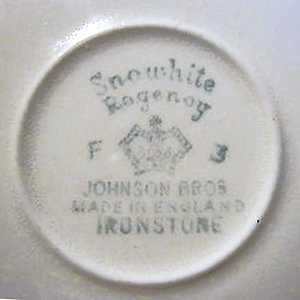Category:Johnson Brothers
From Mystic Tea Room
Johnson Brothers was 19th and 20th century pottery company with offices and plants in North America and Australia. It was founded in 1882 by the brothers Alfred Johnson and Frederick Johnson, with the purchase of the Charles Street Works of Stoke-on-Trent in Staffordshire, England at a bankruptcy sale by Pankhurst & Co. There were four Johnson Brothers in all, and the older brother Henry Johnson soon joined the firm, followed in 1888 by Robert Johnson, who opened a branch office in New York around 1896. Although theirs was a new company, the Johnson Brothers had a great deal of previous experience in the manufacture of sanitary ware and tableware, for they came from a long line of manufacturing potters, being descendants of James Meakin Sr., and therefore relatives of Alfred Meakin and his brothers James Meakin Jr. and George Meakin of J. and G. Meakin pottery. By 1900 the Johnson Brothers were operating five potteries -- the Charles Street Works, Imperial Works, Hanley Works, and Trent Works in Hanley, and Scotia Road Works in Tunstall.
The Johnson Brothers produced both sanitary ware and dinnerware lines. "White Granite" was their first line, and was marketed as "Semi Porcelain," but their tableware soon employed the term "Ironstone" to mark their semi-vitreous lines. The tableware was excellent in quality, very durable, and moderate in price. Their pottery shapes were fairly simple, but they reached the heart of the middle-class market when they branched out into underglaze transfer decorations featuring landscapes and architecture, such as Old Britain Castles, Coaching Scenes, Olde English Countryside, Historic America, Friendly Village, and the like. They also made floral patterns, including Summer Chintz, Hop, and Willow.
As time went on, the sons and grandsons of the original Johnson Brothers joined the firm. Before World War One they owned a sanitary earthenware factory in Germany, but it was closed down in 1914 after England and Germany declared war on one another. During the Great Depression of the 1930s, the original factory on Charles Street was closed, and production slowed, but as soon as they were able, the directors of the firm modernized their factories, and electric tunnel kilns replaced the old coal-fired bottle kilns.
Sales to America continued strong through World War Two and after, especially with the introduction of the Friendly Village and Christmas Plates lines, and by the close of the war, Johnson Brothers was one of the world's largest manufacturers of earthenware and ironstone. Due to popularity of their tableware in North America, compounded by a setback in English production as a result of the damage caused by the war, the company acquired a controlling interest in Sovereign Pottery of Hamilton, Ontario, Canada, in 1947. At this point, much of their business consisted of manufacturing blanks in England and shipping them to Canada and Australia for decoration. During the 1950s, Johnson Brothers was granted Royal Warrants from Queen Elizabeth II and the Queen Mother. Their award-winning designs, such as Old Britain Castles and Historic America, were so popular that the company was twice honoured with the Queen's Award to Industry.
One departure from their practice of using elaborate underglaze transfers to ornament plain shapes was the Snowhite Regency line, an elaborately swirled shape often seen in undecorated white, which was first produced in 1960. This modernistic shape was the basis for The Fortune Cup, a privately commissioned, and very rare cartomancy cup and saucer set created by Verna A. Meredith and John W. Meredith in 1965. This was the company's only tasseomancy cup and it was marketed by the Meredith's not by Johnson Brothers.
In 1968, as multinational consolidation and the rise of melamine plastic table ware was changing the pottery trades, Johnson Brothers, along with Adams, Crown Staffordshire, Coalport, Mason's, Midwinter, and Meakin, all joined the Wedgwood Group. One new pattern from this era which proved popular was 1981's Eternal Beau, but the general trend in tableware was downward, and the Hanley Pottery was closed and demolished in 1995. After this, the Johnson Brothers patterns were reduced in number and the lines were cut back. By 2000 the Johnson Brothers tableware division was moved into the old J. & G. Meakin Eagle Pottery Works, but beginning in 2003, all Johnson Brothers products were made in China, and the Eagle Pottery Works were demolished in 2005. The Waterford Wedgwood group was sold to the Finnish company Fiskars in 2015. Fiskars continued the Waterford and Wedgwood brand names, but discontinued production of the Johnson Brothers brand.
Pages in category "Johnson Brothers"
This category contains only the following page.





